Planting and caring for Iberis
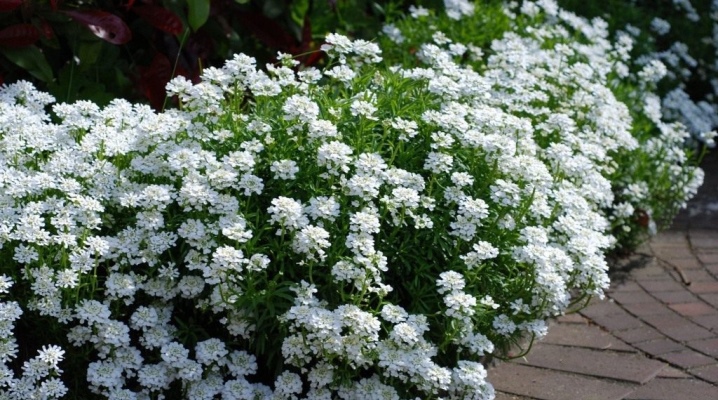
In the modern world, even in the most remote outbacks, people try to make their surroundings more beautiful by planting various flowers. Iberis may be the best option for many gardeners. It is also called Iberian, varifolia, cross-section or stennik. However, the various names do not change the essence, and this type of flower arrangement fits perfectly into any design of the infield. They decorate the edges of lawns, alpine slides, flower beds. And florists love to add Iberis to bouquets.
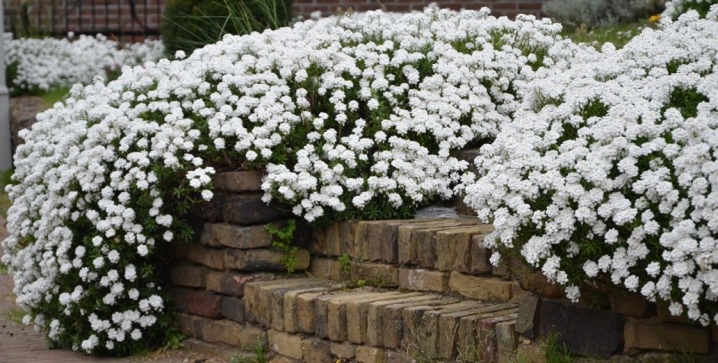
The best varieties to grow
The herbaceous plant Iberis comes from the Cruciferous family. Flowers take root well both in garden spaces and in the wild. For example, in the mountainous places of Asia Minor and Southern Europe, in the Caucasus, in the Crimea, as well as in the lower reaches of the Don. The plant has over 40 species. They are distinguished by their thermophilicity and frost resistance. Among them there are also semi-shrub and herbaceous varieties. Iberis stands out with a certain pivotal structure of the roots, which is why it does not take root well in a new place after transplantation.
The species determines the appearance of the plant. Its shoots often spread along the ground or, conversely, have an erect appearance. The inflorescences are made of small centimeter flowers that look like umbrellas. The leaves are small and dark green. When buds bloom, differing in their color variety, they are able to completely cover the foliage and stems. It should be noted that the flowers smell very strong and pleasant.
This scent can spread over a fairly long distance.
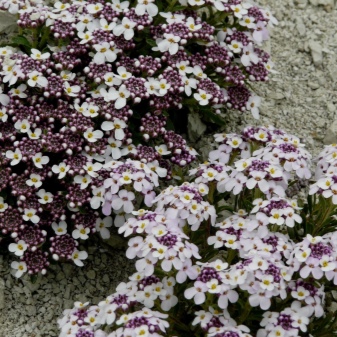
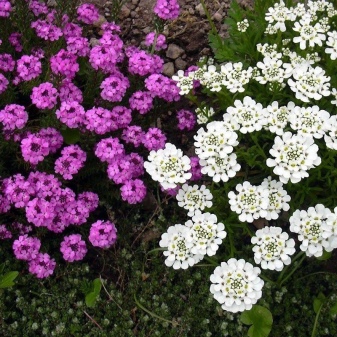
It is beneficial to plant this species, as it begins to bloom in May. It lasts about 2 months. Then the fruits appear, which are a bivalve pod. The fruit is circular or oval in shape and is slightly flattened. The ripe seeds are inside the pod. They can remain viable for 4 years. Before talking about varieties for cultivation, it should be noted that gardeners use only 2 directions of annual Iberis. Next, let's move on to considering the population.
- An annual plant reaches almost 1.5 m in height - this is Iberis umbellata (Iberis umbellata). It has been cultivated since the beginning of the 16th century and has a rather spectacular appearance. Its processes are glabrous and smooth. Alternately located lanceolate leaf plates. The flowers are very fragrant and have a variety of colors. They are part of corymbose inflorescences. It takes about 2 months from planting a plant to its flowering, flowering also lasts about 2 months. Popular varieties: Red Rash and Fairy Mix.
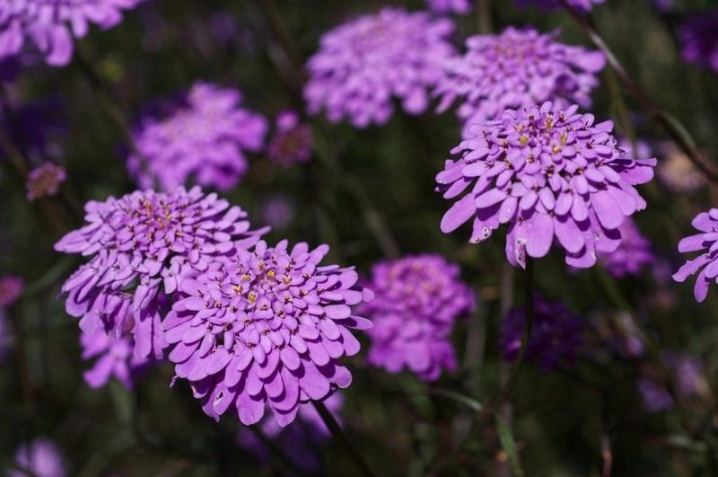
- Annual Iberis bitter (Iberis amara) looks like a down layer on the surface. Therefore, amateurs have been decorating their gardens with it since the 16th century. The most used varieties are: "Tom Tumb"; Weiss Riesen, Hyacintenblutinge Riesen. Reaches a height of about 30 centimeters. Its leaves have alternately arranged leaves with a serrated edge. The racemose inflorescences consist of lilac or white flowers, their size reaches about 2 centimeters.
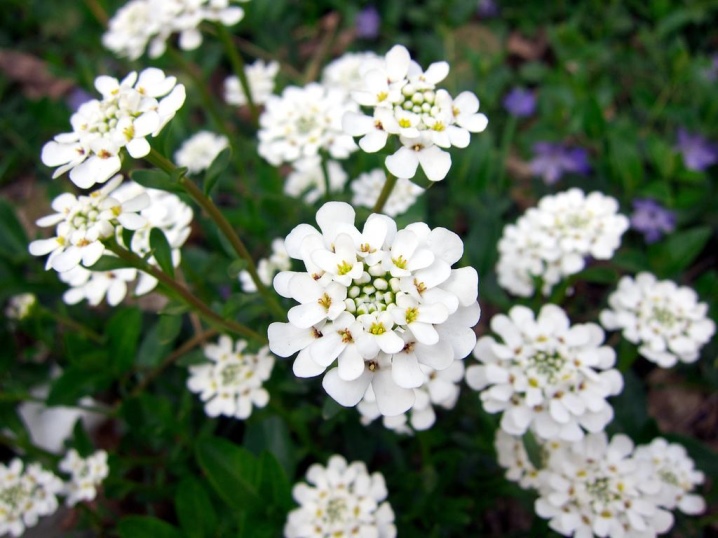
- Semi-shrub specimen - Iberis evergreen (Iberis sempervirens) grows in height up to half a meter. People have been decorating their lawns with it since the 17th century. Has bright green foliage, shimmering gloss. The inflorescences are approximately 5 centimeters in diameter. Blooms vigorously for more than 25 days. The most popular varieties: Findall, Dana.

- Semi-evergreen Iberis gibraltar (Iberis gibraltar) differs in small inflorescences that have a pinkish tint. The plant grows to only 0.25 m in height. The most popular variety is "Gibraltar Candy Taft" due to the fact that its flowers at the beginning of flowering have a lilac color, and later it changes to white
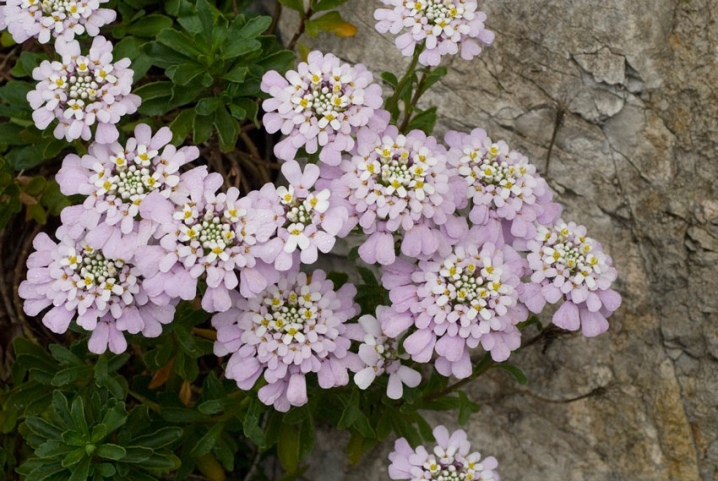
- In height Iberis rocky (Iberis saxatilis) reaches 18 centimeters. Flowers give it an extraordinary beauty, which, during flowering, create the effect of powdered snow.
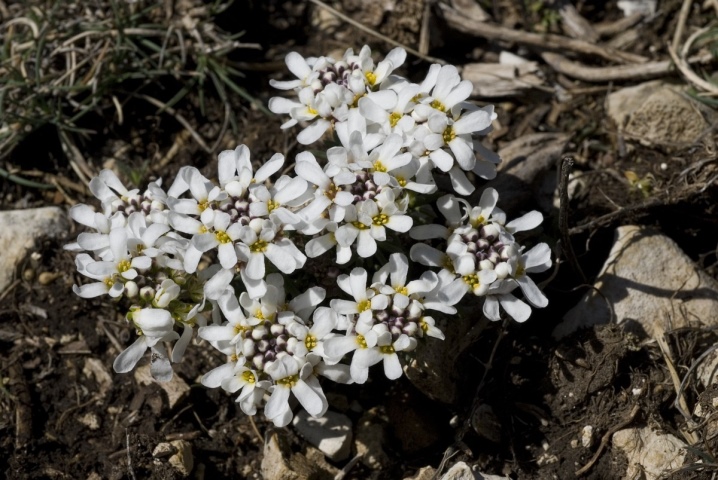
- No less beautiful in appearance is Crimean Iberis (Iberis simplex)... When the buds are first born, they are purple, and when flowering begins, they turn white.
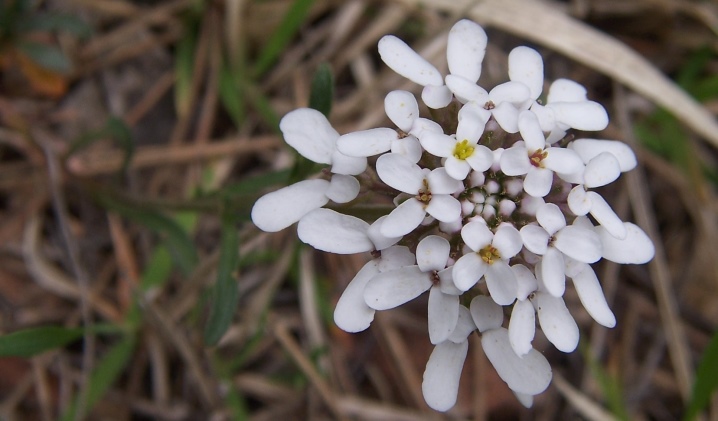
How to grow seedlings from seeds?
To get one hundred percent germination, you must have high-quality seed when planting. Some plant seeds directly in the beds, which they prepare in advance, but the greatest result can be achieved if you start propagating the Iberis with seedlings. More precisely, growing Iberis from seeds is the main method of plant propagation. The sooner you start sowing seeds, the sooner you will get seedlings. Therefore, this process is usually started at the end of February or in the beginning of March. To begin with, the soil is placed in a common container. Since the seeds of Iberis are very small, it is advisable to sow them in this way.
Further, the seed material is simply scattered on the surface of the soil, and then lightly sprinkled with loose earth from above. In order not to harm future seedlings, the ground on the surface is moistened with a spray bottle. Better yet, cover the container with plastic wrap after watering.
This must be done so that moisture does not quickly evaporate from the surface, and the seeds are in favorable conditions for germination.
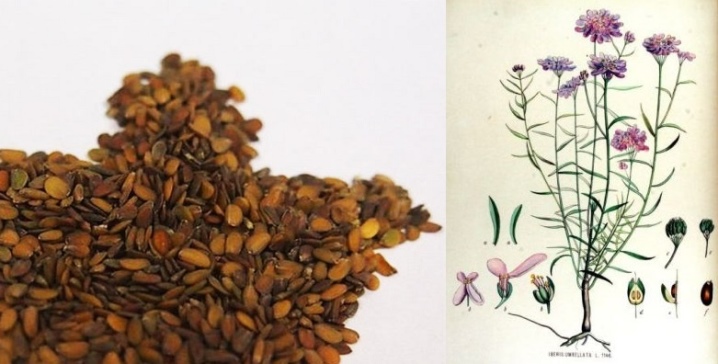
It will take about 2 weeks, and seedlings will appear. Then the film is removed from the container, and after the appearance of the first pair of well-formed leaves, each seedling is dived and transplanted into a separate container (glass). Some amateur flower growers try to plant 2-3 seeds at once in separate cups, so as not to suffer later and not to transplant weak sprouts. By the way, plants planted in this way will begin their flowering much earlier than those that will be subjected to multiple transplants.
Further, the seedlings must be hardened for 12 days, taking them outside in the shade for several hours. Then you can plant seedlings in open ground without fear. Best if it is late May or early June. To do this, prepare the holes, which should be on the light side and be at a distance of 18 cm from each other. When planting seedlings, try not to sprinkle the root collar too much. The soil must have good drainage properties. Sandy or rocky soil is preferable.

How to plant in open ground?
Planting Iberis seeds in open ground can be done in well-lit areas. They must have a good drainage network and not too wet. Planting Iberis in this way begins in April. Better to make the intervals between plantings of about 2-3 weeks. So you will get constant flowering and enjoy this beauty right up to September. It is best to plant seeds to a depth of 1-2 cm.The distance between the rows should be 15-20 cm.
Watering must be done with care so as not to harm future seedlings. When the plants appear on the surface (they sprout very quickly), the beds need to be weeded out and weak shoots removed. A distance of about 15 cm should remain between each sprout. Iberis grows rapidly, so it must be fed with complex fertilizers for flowering plants and watered. In autumn, it is better to place the seeds in the ground with the onset of persistent cold weather around the end of October.
Otherwise, the plants can sprout even before the onset of spring.

How to care?
Iberis lovers appreciate this culture because it is quite unpretentious. Caring for them does not take much time. One has only to carry out a few manipulations with the plant, and it will thank you with lush flowering. It also happens that the plant feels great and without any care about it.
Watering
Care should be taken with watering, since this plant does not like highly waterlogged soils. Of course, he also needs water in certain quantities. Basically, watering must be carried out if there is an unbearable drought on the street. It is best to ensure that the soil around the Iberis is deeply saturated with water from time to time. However, such procedures are necessary for all drought-resistant plants. Again, this should be done when natural precipitation is greatly delayed. But if you do not have enough strength and time to fully care for the Iberis, then it will not die anyway, but will only reduce the period of its lush flowering.
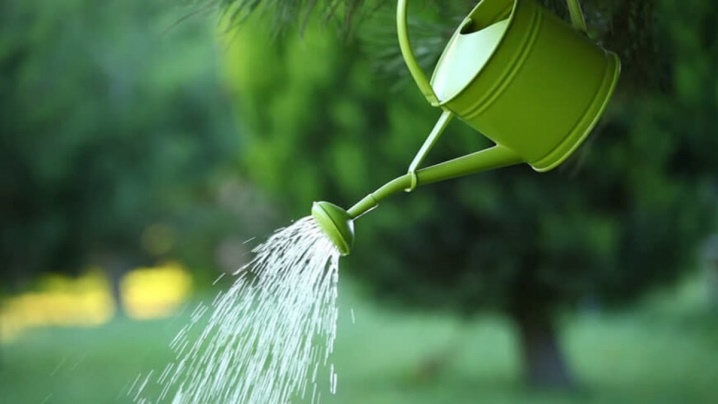
Top dressing
If you think that your soil is poor, then apply fertilizers intended for Iberis about 2 times a year. In fertile areas in flower beds, feeding may not be done. If you placed the plant in a rockery or rock garden, then fertilize according to all standards, applying mineral fertilizers in the spring or in the summer. For this, it is quite possible to use nitrophosphate. Do not give up organic matter when feeding. Usually the flowers are sprinkled around the roots with this fertilizer after pruning. It is a good idea to fertilize the Iberis after flowering with compost, which can also serve as a mulch.

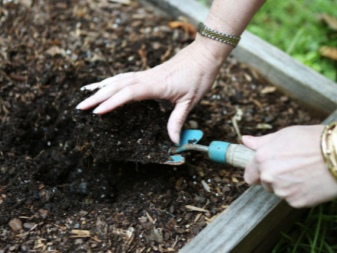
Pruning
Some people think that pruning Iberis is a rather difficult task, so they simply do not carry it out. But it needs to be carried out. Lush flowering is impossible without this procedure. A the pruning process itself is to remove the fading shoots in time. However, remember that pruning Iberis will have to be done at least once a year after flowering is complete.
This will take very little time, and it is necessary to shorten the shoots by about 1⁄3 of the total height of the stems.
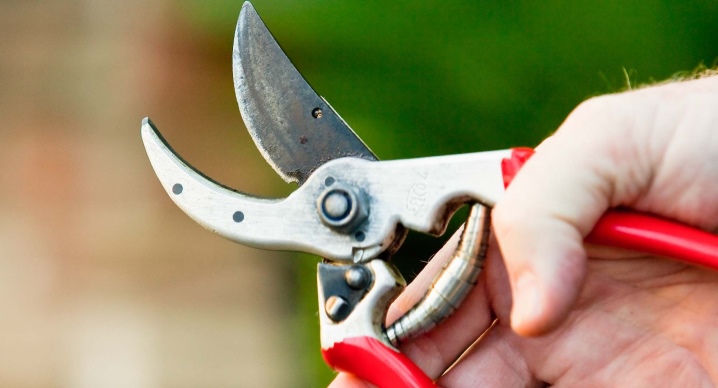
Possible problems
Iberis is considered a rather unpretentious plant. Nevertheless, he also needs some care and help. Especially where he does not have the necessary conditions for him. It must be remembered that on too heavy and wet soils, your plant can suffer from fungal diseases. In addition, if other representatives of Cruciferous plants previously grew on the flower bed, and after that you did not treat it with fungicides and immediately planted Iberis, then the probability that the soil will be infected with cabbage keel is very high (it can be in the ground for several years). This means that your plant will suffer from the fact that its roots begin to deteriorate. Therefore, carry out all the necessary manipulations to avoid the above problems.
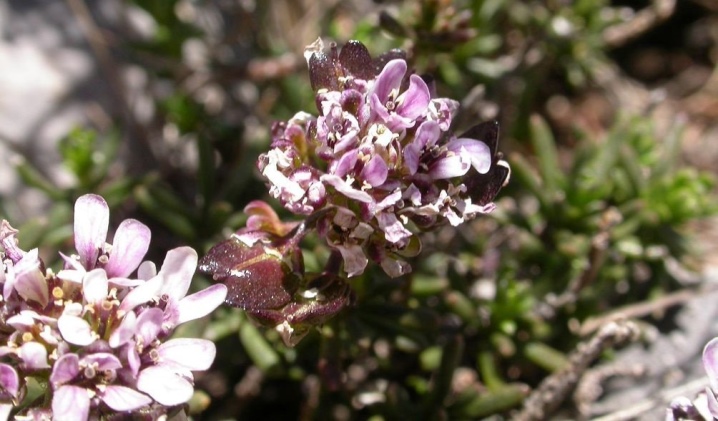
Pests for Iberis also pose a great threat. This plant is easily attacked by earthen fleas, mealybugs and aphids. As soon as you notice holes in the foliage or other characteristic damage, then immediately carry out a thorough treatment with insecticides such as Fitoverm, Aktara, Mospilan. If the Iberis is not pruned during and after flowering, it will drop the seeds onto the soil near the roots. They may well sprout in the spring without any unnecessary care. The shops sell mainly hybrid plants, which, thanks to breeding work, have impeccable flowering.


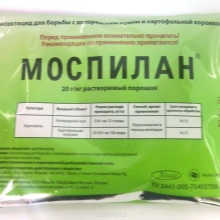
Be aware that hybrids can also self-pollinate. Therefore, the next year after cross-pollination, they are likely to lose their appearance due to a change in the color of the petals. Flowers, for example, may turn white instead of purple. In addition, the inflorescences become much smaller and lose their peculiarity. As already mentioned, Iberis does not tolerate transplantation well. And this problem affects the vitality of the flower. The roots of the Iberis must be dug out so that the roots remain inside the earthen coma. Then they won't get hurt.
Then the problem of transplantation can be bypassed. The seedlings will take root perfectly.
As already known, Iberis tolerates winter frosts well. But if the winter is characterized by the scarcity of snow cover, then the roots of the Iberis may die. This will happen due to temperature changes. In this case, there is also a way out. It is enough to cover your planting for the winter with a special covering material or sprinkle it with fallen leaves or straw. Iberis, with proper care, grows very quickly and begins to occupy all the free space. By this he interferes with other plants. Therefore, it must be thinned out and replanted on time every 5-6 years.
For information on how to grow Iberis, see the next video.







































































































The comment was sent successfully.